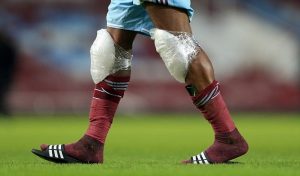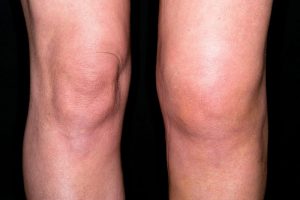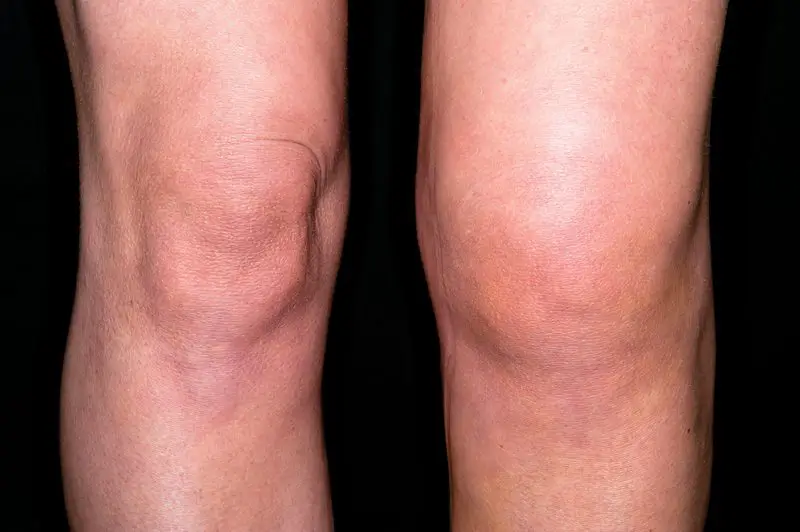Knee Swelling
 Swelling is a common and required response after any surgery. The trauma that occurs from surgical repair causes an increase in swelling that can be hard to manage and this is especially true in the knee. The healing response after surgery results in an influx of fluid into the joint which if not monitored can get out of hand. Managing and trying to decrease swelling is one of the first goals of recovery on your way back to normal. Swelling can be difficult to manage and can seem like a losing battle at times. Chronic swelling within a joint can cause high pain levels, more muscle weakness, and more frequent muscle spasms.
Swelling is a common and required response after any surgery. The trauma that occurs from surgical repair causes an increase in swelling that can be hard to manage and this is especially true in the knee. The healing response after surgery results in an influx of fluid into the joint which if not monitored can get out of hand. Managing and trying to decrease swelling is one of the first goals of recovery on your way back to normal. Swelling can be difficult to manage and can seem like a losing battle at times. Chronic swelling within a joint can cause high pain levels, more muscle weakness, and more frequent muscle spasms.
Is Swelling Bad after Surgery
Swelling is a natural and needed response to trauma that the body requires to start healing. When there is an injury, the body immediately signals it’s own alarm system and sending the body into repair mode. The body begins to form new blood vessels to bring more blood and the early building blocks of repair to the injured joint. The increase in blood flow brings enzymes, collagen, and needed proteins that help reabsorb damaged tissue, remodel the existing tissue and begin building new tissue. Do we really want to stop or slow the process required to heal?
The issue with swelling is if there is too much for too long. We want to simply manage swelling from getting out of hand as it’s a required and much-needed process to heal.
What is Swelling?
 Once the inflammatory process is started, local blood vessels start to dilate and new blood vessels are formed. This brings fluid such as plasma, platelets, proteins, and white blood cells to the area. The white blood cells help with the redness, swelling, and start the repair process. Phagocytes, including Neutrophils, Monocytes, and Macrophages, begin the process of “eating” and devouring damaged cells and tissue. These cells can sometimes cause more irritation within the area due to the break down of tissue. However, this clears the path for new and stronger tissue to be created in the repair phase.
Once the inflammatory process is started, local blood vessels start to dilate and new blood vessels are formed. This brings fluid such as plasma, platelets, proteins, and white blood cells to the area. The white blood cells help with the redness, swelling, and start the repair process. Phagocytes, including Neutrophils, Monocytes, and Macrophages, begin the process of “eating” and devouring damaged cells and tissue. These cells can sometimes cause more irritation within the area due to the break down of tissue. However, this clears the path for new and stronger tissue to be created in the repair phase.
Should We Still Use the R.I.C.E Method to Reduce Swelling?
The R.I.C.E method for treating swelling has been around for a long time. This stands for Rest, Ice, Compression, and Elevation. With recent advances in technology and research, we now know this theory needs to be updated. Icing and the RICE method delays the onset of Insulin-Like Growth Factor which is a much-needed protein required for healing.
We don’t want to delay healing, we want to speed it up.

The best way to speed up healing is through movement, targeted exercises, allowing adequate time, and graded activity.
How Much Swelling is Too Much after Knee Surgery?
This is always a tough question as there is no right answer. It’s a little like Goldilocks porridge; some swelling is good cause it’s healing but too much can cause adverse effects on function. In general, swelling should peak for 24-72 hours after an injury and slowly decrease each day after. An increase in swelling after activity post-surgery is common but any sudden drastic changes in swelling should be seen by a medical professional.

Because muscle will shut down with too much swelling it’s it is important to manage. We don’t want pain and swelling to get to the point where a person’s leg can give out and cause a risk for further injury. The simplest answer is if there is more than 5-6/10 pain and you cannot actively fire the muscles near the knee then it is important to manage the swelling in the following ways.
How to Decrease Inflammation after Surgery
Muscle Pump: Work Those Injured Muscles
In the current research, this is the most effective way to clear swelling deep within the joint. When we tighten our muscles it segmentally squeezes our blood vessels. The squeezing of the veins changes the pressure and pushes the swelling back towards our heart and our lymphatic system. Using our muscles is also one of the best and most effective ways to prevent a DVT or a blood clot in the deep veins. Some of the best exercises to achieve this are ankle pumps and quad sets, but in general, movement is key.
Movement: Motion in Lotion
Joint movement is the best medicine there is. As we just mentioned there are many benefits to get muscles and joints moving to help with pain and blood flow. However, one of the best ways to get sustained joint movement without causing too much pressure on the joint is a recumbent elliptical or an upright bike. Both of these machines allow for a full knee range of motion in a non-weight bearing position. Exercising on these machines for longer than 10 minutes at a time also helps improve muscle strength and endurance, which is greatly reduced after surgery.
Leg Elevation: Help Drain the Swelling Naturally
When we say leg elevation, we mean really get it up there. By raising the leg above the level of the heart it allows gravity to help drain the swelling out of the lower extremities and into the venous/lymph system and then processed naturally by the body. The most common mistake we see is people “elevate” their leg by putting it on a pillow while laying on the couch. This isn’t high enough to make much of a difference. One of the best ways to make sure you are getting enough elevation is with the Abco Tech Leg elevation pillow.
Ice Machine for Knee Swelling
Even though we are moving away from using ice for recovery, there is still a place for it. When edema or pain gets out of hand, using ice is still effective in bringing those you back down to a manageable level. We love the vive ice machine because you can circulate the cold water through a compress. You can disconnect yourself and walk short distances if needed and can leave it on between icings. Ice for no more than about 20-25 minutes and no more than once per hour. We also reviewed the best ice machines for knee swelling earlier this year so be sore to check it out.
Compression Socks
You probably got something similar from the surgeon’s office right after surgery and were told to wear them for two weeks, right? Those compression socks are usually way more expensive and no better than you can get yourself. We recommend getting some compression socks that are long enough to go over the knee to about the mid-thigh level. We recommend more than 15 mmHg of pressure for light swelling and more than 20 mmHg for joint swelling after surgery. Our favorite compression socks are the Mojo Compression Stockings.
Medication – Not Your First Option
Thanks to Amazon you can now buy 500 Ibuprofen for less thatn 10$. We put medication at the bottom of our list simply because it’s our least favorite, but we want to mention it because it does work. Anti-inflammatories such as Ibuprofen do reduce swelling but we caution against long term use do to risk of impaired kidney function and increased cardiovascular event risk. Always check with your physician if you are already taking other medications to watch for potentially dangerous drug interactions.
Massage – Self Treatment at Home
This may be everyone’s favorite way to decrease swelling because it feels good! However, we want to caution that massage gets more credit than it should in recovery. It feels good because it reduces the nervous system’s response to pain but it doesn’t have much of a long term benefit. Massage also helps with superficial swelling but has not shown to help intra-articular or welling deep within the joint. The deep joint swelling is the type of swelling that is present after most surgeries such as a total knee replacement or meniscus surgery. If you don’t want to pay for a massage you can try a personal massager such as the Damkee Massage Gun on yourself to help clear some of the swelling out.
Conclusion
Swelling is an expected and needed response for healing after any surgery. We want some swelling to properly heal but want to make sure that it doesn’t get out of hand. The past theory of using the R.I.C.E method is no longer supported unless there is an abnormal swelling response. Instead, focus on active solutions such as movement and muscle use to pump swelling out of the knee.
Works Referenced:
-
Loss of Knee-Extension Strength Is Related to Knee Swelling After Total Knee Arthroplasty
- Effects of cryotherapy on arthrogenic muscle inhibition using an experimental model of knee swelling
-
Effect of compression therapy on knee swelling and pain after total knee arthroplasty
-
Management of knee pain and stiffness after total knee arthroplasty
Picture Credit:
https://en.wikipedia.org/wiki/Phagocyte#/media/File:Neutrophil_with_anthrax_copy.jpg
Disclaimer: The information provided in this post is for educational purposes only. This is not a substitute for a medical appointment. Please refer to your physician before starting any exercise program.






